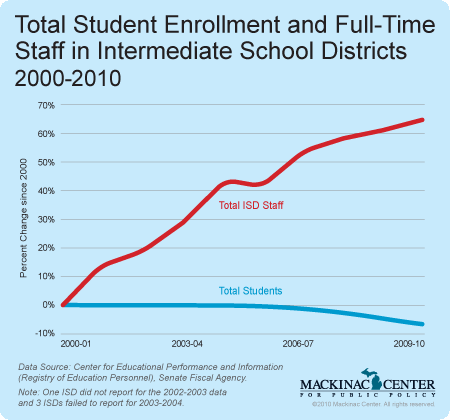ISD Bloat?
Payrolls at Intermediate School Districts Grow Dramatically While Enrollment Declines
The number of school employees for each student in Michigan's public school system has been rising for most of the past 15 years, and stands now at one employee for every eight students. This is surprising given Michigan's declining economy over the last decade and the school establishment's perpetual complaints of being underfunded. But even more startling trends emerge when the data are dissected further.
Between 2000 to 2009, enrollment in all of the state's public schools declined by 6.4 percent. As illustrated by the chart below, however, the number of full-time staff on Intermediate School Districts' payrolls grew by 64 percent. ISDs are government entities that were created in 1962 to provide services such as accounting, auditing and professional development to local school districts. They can also raise funds for special and vocational education services. There are 57 ISDs in Michigan.
Unlike conventional school districts, where funding levels are tied to the number of students who attend each year, ISDs derive much of their revenue from local property taxes. When the housing bubble was inflating — and with it property tax assessments — local millage revenue funneled ever more cash into ISD coffers regardless of whether enrollment in their constituent school districts was rising or falling. This allowed them to hire more employees.
It could be that the dramatic staff increase reflects the transfer of some operations from local schools to the ISD level, which would be in keeping with the original intent of ISDs. If this is what has been happening, then one would expect to see a corresponding decline in staff levels at the local district level.
That's not the case, however. Student enrollment in local districts has fallen by 9.8 percent since 2000, while their full-time staff numbers are down just 8.5 percent. These figures do not suggest any significant transfer of services to the ISDs.
In contrast to these trends, staffing at charter public schools appears much more lean. From 2000 to 2009, charter school enrollment increased by 97 percent, while the number of staff grew by just 79 percent. Unlike ISDs, for most charter schools funding is tied almost exclusively to the number of students, not property tax receipts, so operating efficiently and avoiding a glut of non-essential employees is critical to their success.
ISDs will claim correctly that over this period the Legislature has given them more duties to perform, which would account for some marginal increases in overall staff levels. The very large increases suggest that something else is going on, and that a cash-strapped state should re-examine the role of this middle level of school management. Rather than creating efficiencies and economies-of-scale, they may have become what they were intended to alleviate — excessive layers of bureaucracy.
Michigan Capitol Confidential is the news source produced by the Mackinac Center for Public Policy. Michigan Capitol Confidential reports with a free-market news perspective.

